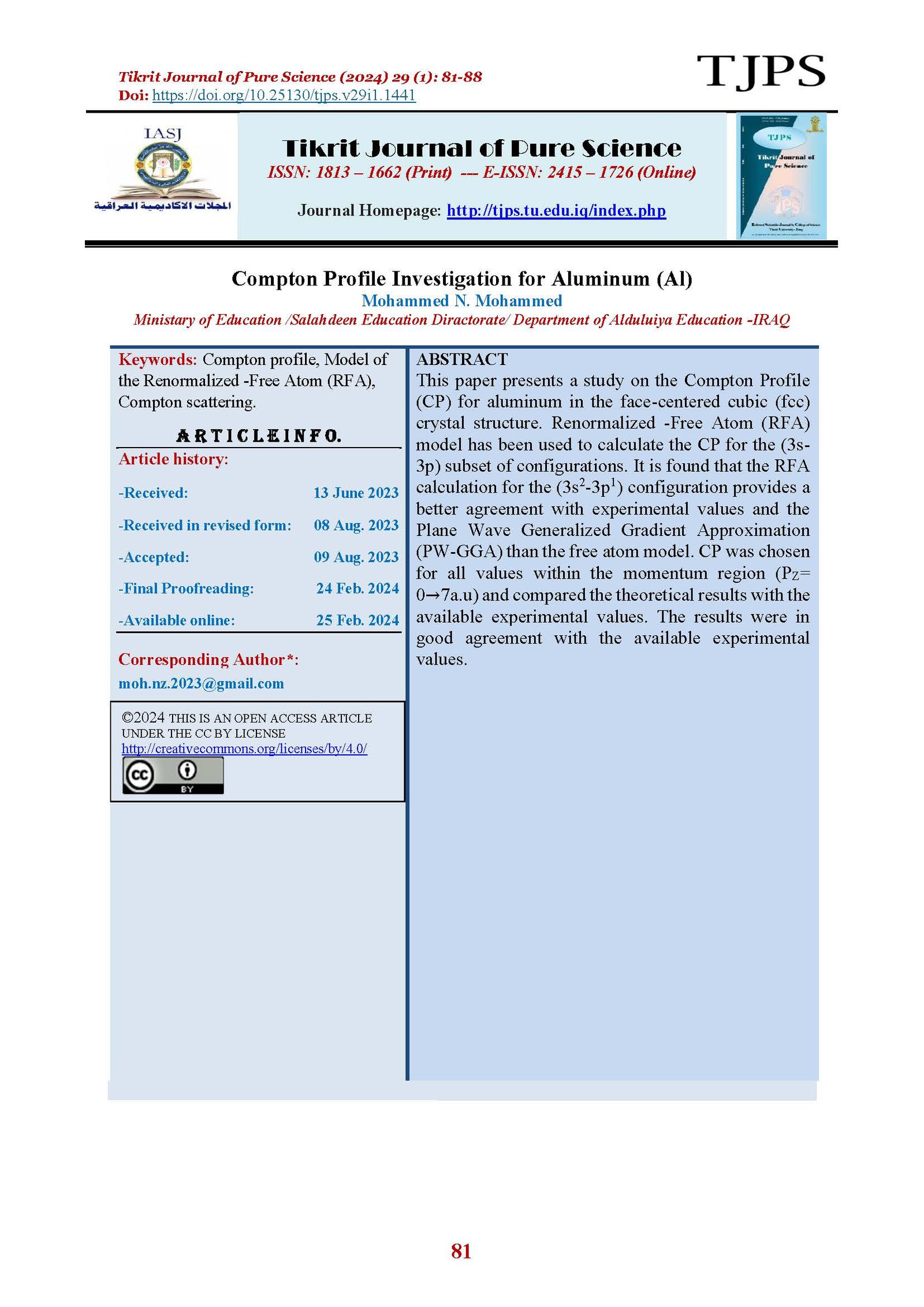Compton Profile Investigation for Aluminum (Al)
Main Article Content
Abstract
This paper presents a study on the Compton Profile (CP) for aluminum in the face-centered cubic (fcc) crystal structure. Renormalized -Free Atom (RFA) model has been used to calculate the CP for the (3s-3p) subset of configurations. It is found that the RFA calculation for the (3s2-3p1) configuration provides a better agreement with experimental values and the Plane Wave Generalized Gradient Approximation (PW-GGA) than the free atom model. CP was chosen for all values within the momentum region (PZ= 0 7a.u) and compared the theoretical results with the available experimental values. The results were in good agreement with the available experimental values.
Article Details

This work is licensed under a Creative Commons Attribution 4.0 International License.
Tikrit Journal of Pure Science is licensed under the Creative Commons Attribution 4.0 International License, which allows users to copy, create extracts, abstracts, and new works from the article, alter and revise the article, and make commercial use of the article (including reuse and/or resale of the article by commercial entities), provided the user gives appropriate credit (with a link to the formal publication through the relevant DOI), provides a link to the license, indicates if changes were made, and the licensor is not represented as endorsing the use made of the work. The authors hold the copyright for their published work on the Tikrit J. Pure Sci. website, while Tikrit J. Pure Sci. is responsible for appreciate citation of their work, which is released under CC-BY-4.0, enabling the unrestricted use, distribution, and reproduction of an article in any medium, provided that the original work is properly cited.
References
1. Mendonça, J. T., and Haas, F. (2023). Compton scattering of plasmons. Physica Scripta, 98(6), 065603. 2. Fathi, S. J. (2021). Properties and Electrical of Nano composite (Ni1-xSrxFe12O19) prepared by sol-gel. Samarra Journal of Pure and Applied Science, 3(4), 134-147. 3. Darweesh, S. Y., Jumaa, I. H., and ALYAR, H. (2023). Effect of Repeated Additions of Silica Nanoparticles on the Physical Properties of Nickel. Samarra Journal of Pure and Applied Science, 5(2), 104-117.
4. Mohammed, F. M., Salih, S. H., and Mohammed, S. A. (2018). A study of electron momentum density in Ti_Al system. Tikrit Journal of Pure Science, 23(4), 96-101. 5. Meena, Seema Kumari, and B. L. Ahuja. (2018) Electronic structure and electron momentum densities of Ag2CrO4. AIP Conference Proceedings. Vol. 1953. No. 1. AIP Publishing LLC, AIP Conf. Proc. 1953, 110026-1–110026-4. 6. Joshi, Ritu, Jagrati Sahariya, and B. L. Ahuja. (2011) Compton scattering study and electronic properties of vanadium carbide: A validation of hybrid functional. Physica B: Condensed Matter 406.10: 2007-2012. 7. James, A. D., Sekania, M., Dugdale, S. B., and Chioncel, L. (2021). Magnetic Compton profiles of Ni beyond the one-particle picture: Numerically exact and perturbative solvers of dynamical mean-field theory. Physical Review B, 103(11), 115144. 8. Ghaleb, A. M. (2018). Investigation of electronic structure for β-Zr in the (s-d) subshell. Tikrit Journal of Pure Science, 21(6), 126-131. 9. Gu, Y. J., Klimo, O., Bulanov, S. V., and Weber, S. (2018). Brilliant gamma-ray beam and electron–positron pair production by enhanced attosecond pulses.Communications Physics, 1(1), 93. 10. Meena, Seema Kumari, et al. (2019) Performance of hybrid exchange-correlation potential for photocatalytic silver chromate and molybdate: LCAO theory and Compton spectroscopy. Physica B: Condensed Matter 560: 236-243. 11. Heda, N. L., et al. (2010) Electronic properties and Compton profiles of molybdenum dichalcogenides. Journal of Physics and Chemistry of Solids 71.3: 187-193. 12. Ruotsalainen, K. O., Inkinen, J., Pylkkänen, T., Buslaps, T., Hakala, M., Hämäläinen, K., and Huotari, S. (2018). The isotropic Compton profile difference across the phase transition of VO 2. The European Physical Journal B, 91, 1-6. 13. Kaliman, Z., K. Pisk, and R. H. Pratt. (2011) Compton scattering from positronium and validity of the impulse approximation. Physical Review A 83.5: 053406: 14. Khalaf, M., and Kaminer, I. (2023). Compton scattering driven by intense quantum light. Science Advances, 9(1), eade0932. 15. Onitsuka, Y., Tachibana, Y., and Takahashi, M. (2022). Asymptotic behavior of the electron-atom Compton profile due to the intramolecular H-atom motion in H 2. Physical Chemistry Chemical Physics, 24(33), 19716-19721.
16. Cooper, M. J. (1985). Compton scattering and electron momentum determination. Reports on Progress in Physics, 48(4), 415. 17. Khera, S., S. Mathur, and B. L. Ahuja. (2007) Electronic structure of hafnium: A Compton profile study. Pramana 68: 91-98. 18. Biggs, F., Mendelsohn, L. B., and Mann, J. B. (1975). Hartree-Fock Compton profiles for the elements. Atomic data and nuclear data tables, 16(3), 201-309. 19. Felsteiner, J., Fox, R., and Kahane, S. (1972). Symmetry of the Compton profile of polycrystalline aluminum. Solid State Communications, 11(5), 635-638. 20. Cooper, M., Pattison, P., Williams, B., and Pandey, K. C. (1974). The Compton profile of aluminium. Philosophical Magazine, 29(6), 1237-1243. 21. Aguiar, J. C., Di Rocco, H. O., and Mitnik, D. (2013). Experimental Compton profiles of Be, Al and Ti and comparisons to generalized gradient approximation calculations. Journal of Physics and Chemistry of Solids, 74(10), 1341-1348. 22. Clementi, E., and Roetti, C. (1974). Roothaan-Hartree-Fock atomic wavefunctions: Basis functions and their coefficients for ground and certain excited states of neutral and ionized atoms, Z≤ 54. Atomic data and nuclear data tables, 14(3-4), 177-478. 23. Chodorow, M. I. (1939). The band structure of metallic copper. phys. Rev, 55, 675. 24. Sharma, G., et al. (2011) Compton profile and charge transfer study in intermetallic Ti–Al system. Intermetallics 19.8 :1107-1114.
